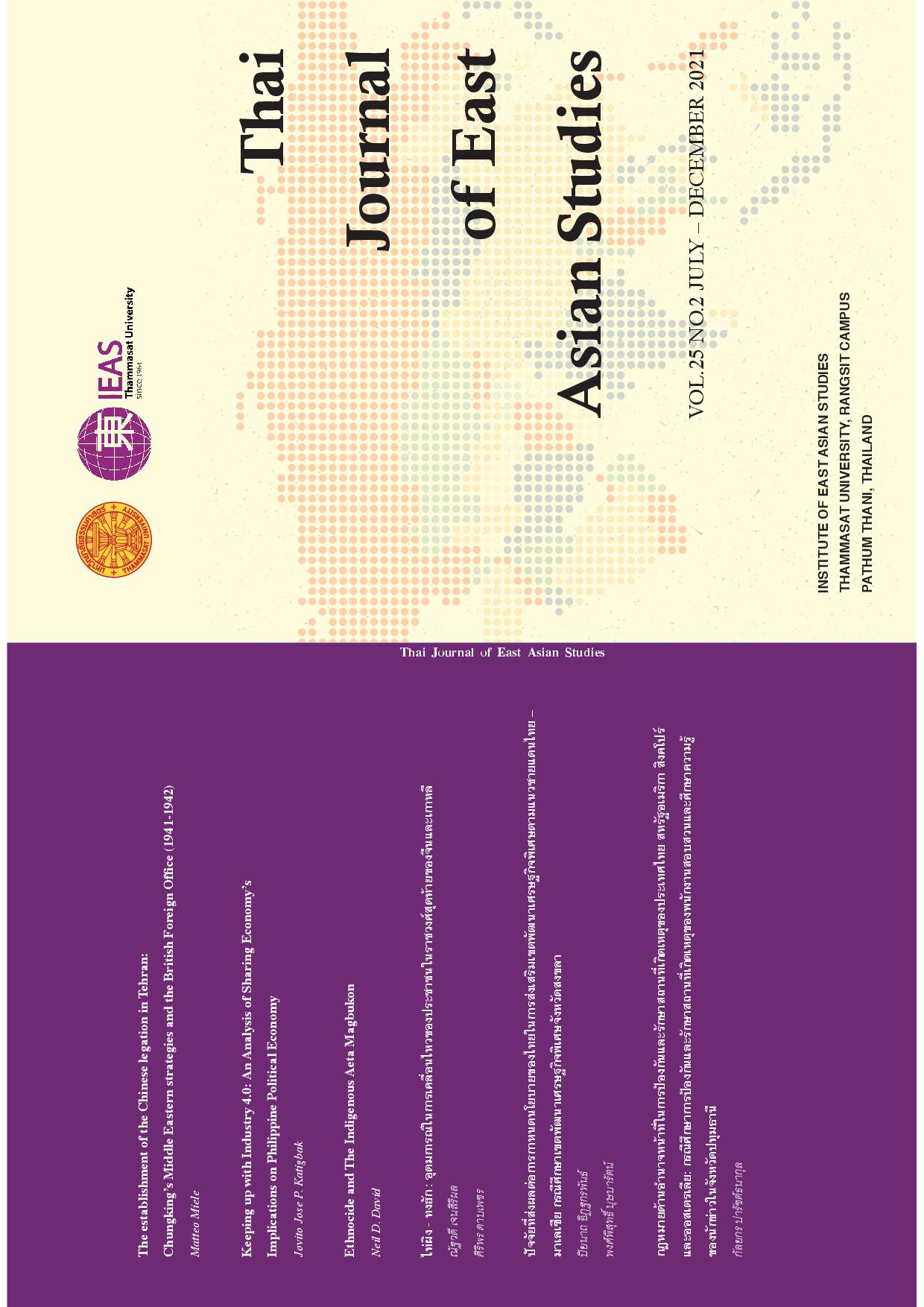Taiping - Donghak : Ideologies for The Popular Movements in the Last Dynasties of China and Korea
Keywords:
Taiping, Donghak, Qing, Joseon, Popular MovementAbstract
This research article attempts to analyse and study the contexts and ideologies that lead to the Taiping popular movement and the Donghak popular movement. The results of the study revealed that the Taiping and Donghak popular movements were not only comparable in the time and the context in which the movements happened, but they also were compared in their
ideologies and the consequences to the dynasties.
The Qing and the Joseon were the last dynasties of China and Korea to be faced similarly with both internal disturbances and the external influences of imperialism from the beginning of the nineteenth century. The Taiping popular movement (1851-1864) occurred in the late Qing (1644-1912) dynasty and was incubated in the impoverished southernmost area, full of radical ethnic discrimination. Likewise, the Donghak popular movement (1894-1895) emerged in the late Joseon (1392-1910) dynasty in the Southern provinces where many suffered from poverty and corruption from local officers.
Their ideologies for the movements were based on religious dogma, egalitarianism, and being anti-foreigner. The Taiping principles were the combination of Christianity and ancient Chinese beliefs, the utopian ideal of equality in the land and treasury, anti-Manchus, and anti-Confucianism. Comparably, the Donghak concepts were humanism, farmland distribution, and “Donghak Religion” - Eastern Learning, founded in the 1860s by Choe Je-u. The Donghak religion, which was recently known as Cheondoism or The Heavenly Way, was a fusion idea of Confucianism, Taoism, Buddhism, and Korean Shamanism. It was used to react to the “Seohak” - Western Learning.
Downloads
References
จอห์น เค แฟร์แบงค์. (2525). เอเชียตะวันออกยุคใหม่ เล่มหนึ่ง [East Asia, The Modern Transformation] (พิมพ์ครั้งที่ 2). มูลนิธิโครงการตำราสังคมศาสตร์และมนุษยศาสตร์.
วาสนา วงศ์สุรวัฒน์. (2555). หงซิ่วเฉวียน: ต้นแบบนักปฏิวัติจีน. ใน ปกรณ์ ลิมปนุสรณ์ (บก.), เหตุเกิดในราชวงศ์ชิง. ชวนอ่าน.
ศิริพร ดาบเพชร. (2562). ประวัติศาสตร์เอเชียตะวันออกสมัยใหม่. คณะสังคมศาสตร์ มหาวิทยาลัยศรีนครินทรวิโรฒ.
เส้า หย่ง และ หวัง ไห่เผิง. (2560). หลังสิ้นบัลลังก์มังกร: ประวัติศาสตร์จีนยุคเปลี่ยนผ่าน [一本书读懂中国近代史] (พิมพ์ครั้งที่ 2). มติชน.
ไพบูลย์ ปีตะเสน. (2555). ประวัติศาสตร์เกาหลี: จากยุคเผ่าพันธุ์ถึงยุคสาธารณรัฐใหม่. (พิมพ์ครั้งที่ 2). โพสต์บุ๊กส์.
Asia for Educators, Columbia University. (n.d.-a). The Land System of the Heavenly Kingdom. http://afe.easia.columbia.edu/ps/cup/taiping_economic_pgm.pdf
Asia for Educators, Columbia University. (n.d.-b). The Tonghak Religion and Uprising: Ch'oe Cheu on Learning Truth and Twelve Reforms Proclaimed by the Tonghak Overseer's Office. http://afe.easia.columbia.edu /ps/korea/tonghak_rebellion.pdf
Bae, H. S. (2017). Popular Movements and Violence in East Asia in the Nineteenth Century: Comparing the Ideological Foundations of their Legitimation. Sungkyun Journal of East Asian Studies, 17(2), 233-260.
Beirne, P. (2009). Su-un and His World of Symbols: The Founder of Korea's First Indigenous Religion. Routledge.
Cheng, J. C. (1963). Chinese sources for the Taiping Rebellion, 1850-1864. Hong Kong University Press.
De Bary, W. T., Bloom, I., & Lufrano, R. J. (1999). Sources of Chinese tradition: From 1600 Through the Twentieth Century. Columbia University Press.
Hail, W. J. (1927). Tsêng Kuo-fan and the Taiping rebellion: with a short sketch of his later career. Yale University Press.
Kang, W. J. (1968). Belief and Political Behavior in Ch'ondogyo. Review of Religious Research, 10(1), 38-43. https://doi.org/10.2307/3510671
Kim, S. (2011). Liang Fa's Quanshi liangyan and its impact on the Taiping Movement. [Doctoral dissertation]. Baylor University. http://hdl.handle.net/2104/8225
Lee, A. C. C. (2008). The Bible in China: Religion of God’s Chinese Son. The Princeton Theological Seminary, 29, 21-38.
Lee, C. S. (1963). The Politics of Korean Nationalism. University of California Press.
Lew, Y. I. (1990). The Conservative Character of the 1894 Tonghak Peasant Uprising: A Reappraisal with Emphasis on Chŏn Pong-jun's Background and Motivation. The Journal of Korean Studies, 7, 149-180. https://doi.org/10.1353/jks.1990.0012
Michael, F. H., & Chang, C. l. (1972). The Taiping Rebellion; history and documents. University of Washington Press.
Moon, M. S. (2017). Donghak and the God of Choe, Je-u: Through the Donggyeong-Daejeon and the Yongdam Yusa [Donghak and the God of Choe, Je-u:]. Catholic Theology and Thought, 79(1), 218-260. http://dx.doi.org/10.21731/ctat.2017.79.218
R. Keith, S. (2014). From Empire to People’s Republic. In A. J. William (Ed.), Politics in China: An Introduction (2nd edition). Oxford University Press.
Rhee, H. B. (2007). Asian millenarianism: an interdisciplinary study of the Taiping and Tonghak rebellions in a global context. Cambria Press.
Seth, M. J. (2010). A concise history of modern Korea: From the late nineteenth century to the present. Rowman & Littlefield.
Setton, M. (2000). Confucian Populism and Egalitarian Tendencies in Tonghak Thought. East Asian History, 20, 121-144.
Shin, S. S. (1978-1979). The Tonghak Movement: From Enlightenment to Revolution. Korean Studies Forum 5 (Winter-Spring 1978-1979), Seoul.
Shin, Y. H. (1994). Conjunction of Tonghak and the Peasant War of 1894. Korea Journal, 34(4), 59-75.
Spence, J. D. (2013). The search for modern China (3rd ed.). W.W. Norton & Company.
The Taiping revolution. (1976). Foreign Languages Press.
Wang, C. C. (王慶成). (1981). Hung Hsiu-chuan's Early Thought and the Taiping Revolution. Renditions: A Chinese - English Translation Magazine, 1981(15), 108-138.
Wei, X. (2014). A Study on Political Thoughts Produced in the Taiping Rebellion. Higher Education of Social Science, 6(2), 84-88.
洪秀全. (n.d.-a). 原道救世歌.https://zh.m.wikisource.org/zh/原道救世歌
洪秀全. (n.d.-b). 原道覺世訓. https://zh.m.wikisource.org/zh/原道覺世訓
천도교 중앙총부. (n.d.-a). 안심가. http://www.chondogyo.or.kr/niabbs4/bbs.php?bbstable=yousa&no=2&page=1
천도교 중앙총부. (n.d.-b). 용담유사. http://www.chondogyo.or.kr/niabbs4/bbs.php?bbstable=yousa
Downloads
Published
How to Cite
Issue
Section
License
Copyright (c) 2021 Thai Journal of East Asian Studies

This work is licensed under a Creative Commons Attribution-NonCommercial-NoDerivatives 4.0 International License.



